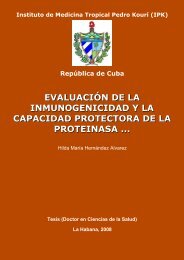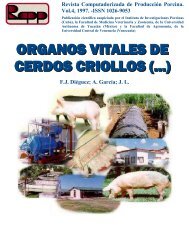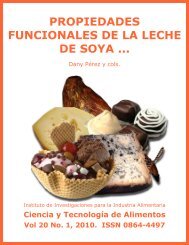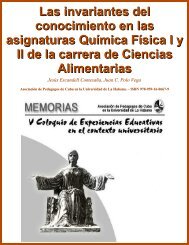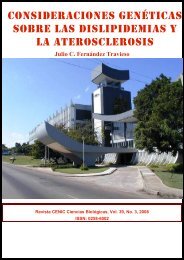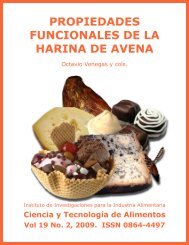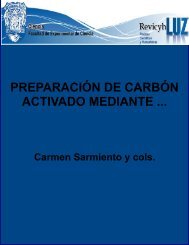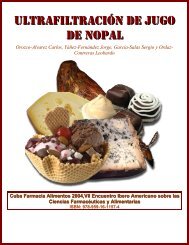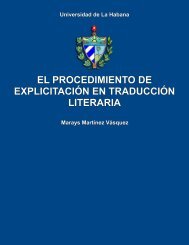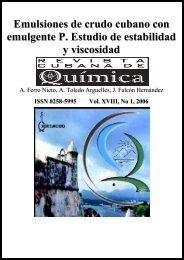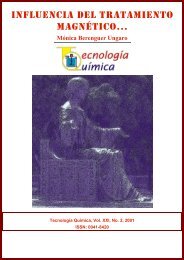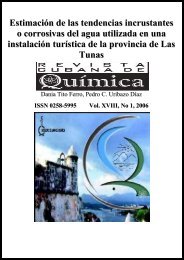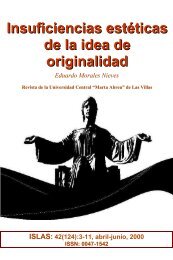Respuesta del amaranto a dos distancias de siembra y a ...
Respuesta del amaranto a dos distancias de siembra y a ...
Respuesta del amaranto a dos distancias de siembra y a ...
You also want an ePaper? Increase the reach of your titles
YUMPU automatically turns print PDFs into web optimized ePapers that Google loves.
REVISTA CIENTÍFICA<br />
Instituto Nacional <strong>de</strong> Investigaciones<br />
Agricolas<br />
AGRONOMÍA TROPICAL<br />
Volumen 60 - No 3, 2010<br />
RESPUESTA DEL AMARANTO A DOS<br />
DISTANCIAS DE SIEMBRA ...<br />
Rodolfo Repollo
Instituto Nacional <strong>de</strong> Investigaciones<br />
Agricolas<br />
REVISTA CIENTÍFICA AGRONOMÍA TROPICAL<br />
ISSN: 0002-192X Depósito Legal pp. 195102AR73
RESUMEN<br />
El objetivo <strong>de</strong> este estudio fue evaluar el comportamiento<br />
<strong>de</strong> tres genotipos <strong>de</strong> <strong>amaranto</strong>, Amaranthus sp.; con la<br />
finalidad<strong>de</strong>utilizarlosencosechamecánica.Estosfueronsembra<strong>dos</strong><br />
en la Facultad <strong>de</strong> Agronomía, Univer sidad<br />
Nacio nal La Pampa en surcos separa<strong>dos</strong> a 0,25 y 0,50 m y<br />
<strong>de</strong>nsida<strong>de</strong>s <strong>de</strong> 100 x 10 3 , 200 x 10 3 y 400 x 10 3 plantasha -1 .<br />
Se midió la altura <strong>de</strong> las plantas y la radiación fotosintéticamente<br />
activa a los 30 días <strong>de</strong>spués <strong>de</strong> la <strong>siembra</strong> (DDS)<br />
enlaantesisymadurezfisiológica,asícomo,elíndice<strong>de</strong>cosecha(IC)yrendimiento<strong>de</strong>semilla.Estadísticamenteeldiseñofue<strong>de</strong>bloquesalazarcon4réplicasx3genotiposx3<strong>de</strong>nsida<strong>de</strong>sx2<strong>distancias</strong>.Nohubodiferenciassignificativas(P=0,01)enelICyrendimientoengrano<br />
(kgha -1 ) en los tres genotipos, entre <strong>distancias</strong> en surcos<br />
y<strong>de</strong>nsida<strong>de</strong>s.La intercepción solar (IS) a los 30 DDS<br />
(51,2%)solodifiriósignificativamente(P=0,01)enA.<br />
cruentus var. Don Guiem, para la distancia <strong>de</strong> 0,25 m<br />
y 100.000 plantas ha -1 . Las plantas en la madurez nopresentaron<br />
diferencias para los distintos tratamientos.<br />
Las <strong>de</strong>nsi da<strong>de</strong>s a campo oscilaron entre 50-90 x 10 3 ,<br />
90-150 x 10 3 y 150-270 x 10 3 plantasha -1 , explicando<br />
lafalta<strong>de</strong>significanciaentretratamientos.<br />
Palabras Clave: Amaranthus sp.; <strong>de</strong>nsidad <strong>de</strong> población;<br />
distancia entre surcos; rendimiento <strong>de</strong> semilla;<br />
NOTA TÉCNICA<br />
RESPUESTA DEL AMARANTO A DOS DISTANCIAS DE SIEMBRA<br />
Y A DENSIDADES DE POBLACIÓN 1<br />
AMARANTH’S RESPONSE TO TWO PLANTING DISTANCES<br />
AND POPULATION DENSITY 1<br />
287<br />
AgronomíaTrop.60(3):287-293.2010<br />
Rodolfo Repollo*, Rosa <strong>de</strong> Troiani*, Elke Nollemeyer*, Teresa Sánchez* y Nilda Reinaudi*<br />
1 ProyectofinanciadoporlaComunidadEconómicaEuropea.<br />
*Profesores.UniversidadNacional<strong>de</strong>LaPampa(UNLPam).Facultad<strong>de</strong>Agronomía.ProyectoAmaranth:Future-Food.<br />
Argentina.E-mail:rodolforepollo@hotmail.com<br />
SUMMARY<br />
Fieldstudieswereconductedtoevaluatethebehaviorofamaranths,Amaranthussp.;withthepurposeofbeingabletousetheminthemechanicalcrop.ThreeamaranthsweresowedintheFacultad<strong>de</strong>Agronomía,Universidad<br />
Nacional La Pampa in furrows separated to 0,25 and<br />
0,50 m and <strong>de</strong>nsities of 100 x 10 3 ; 200 x 10 3 and 400 x<br />
10 3 plantsha -1 .Theheightofplants,photosynteticallyactive<br />
radiation (30 days of the sowing, anthesis andphysiological<br />
maturity),), harvest in<strong>de</strong>x of crop andseed<br />
yield were measured. Experimental <strong>de</strong>sign was<br />
totallyrandomizedblocks:4replicationsx3genotypesx<br />
3 <strong>de</strong>nsities x 2 distances. There were no significantdifferences(P=0,01)intheharvestin<strong>de</strong>xofcropandgrainyield(expressedinkgha<br />
-1 ),inthe3genotypesbetweendistancesinfurrowsand<strong>de</strong>nsities.Thesolarinterceptionat30daysofthesowing(51,2%),onlydiferedsignificantly<br />
(P=0,01)inA. cruentusvar.DonGuiemforthedistanceof<br />
0,25 m and 100.000plantsha -1 .Atmaturitytherewerenotsignificantdifferenttreatments.The<strong>de</strong>nsitiesinthefieldranged<br />
between 50-90 x 10 3 , 90-150 x 10 3 and 150-270 x<br />
10 3 plantsha -1 whichwouldexplainthelackofsignificancebetween<br />
treatments.<br />
Key Words: Amaranthus sp.; distance between furrows;<br />
grain yield; population <strong>de</strong>nsity.<br />
RECIBIDO:junio25,2010 ACEPTADO:noviembre15,2010
Vol.60-2010 AGRONOmíATROPICAL Nº 3<br />
INTRODUCCIÓN<br />
El <strong>amaranto</strong>, Amaranthus sp., es un cultivo ancestral,<br />
queconstituyóelalimentobásico<strong>de</strong>losincas,mayas,aztecasyotrosgruposprecolombinos<strong>de</strong>todaAmérica<br />
(Sauers, 1950). Su excepcional adaptabilidad, conjuntamente<br />
con la cantidad y calidad <strong>de</strong> proteínas, produce<br />
en la actualidad una especial atención como opción para<br />
lapequeñaescala(Downton,1973;Vietmeyer,1982).<br />
Por sus características, este cultivo se presenta como una<br />
alternativapotencialparaunasuperficie<strong>de</strong>aproximadamente5000000ha,ubicadasenlaregiónsemiárida<strong>de</strong><br />
Argentina, al norte <strong>de</strong> la Patagonia, con precipitaciones<br />
comprendidas entre 400 y 800 mm anuales (Covas,<br />
1984).<br />
Bansalet al. (1955), Hen<strong>de</strong>rson et al.(2000)yTorres<br />
Saldaña et al.(2006)encontraronquealtas<strong>de</strong>nsida<strong>de</strong>spermitieron<br />
incrementar la producción <strong>de</strong> semilla, por<br />
su parte, el cultivo presentó menor acame, <strong>de</strong>bido posiblemente<br />
a una reducción <strong><strong>de</strong>l</strong> peso total <strong>de</strong> la planta. Así<br />
mismo, Peiretti y Gesumaria (1991), observaron una<br />
disminuciónsignificativaenlaobtenciónindividual<strong>de</strong>semilla<br />
<strong>de</strong> Amaranthus cruentus L. con el aumento <strong>de</strong><br />
la <strong>de</strong>nsidad entre 100.000 y 400.000plantasha -1 , aún<br />
cuandosimultáneamenteseprodujounincrementoenelrendimientoporunidad<strong>de</strong>superficie.<br />
EnlaFacultad<strong>de</strong>Agronomía,UNLPam,Argentina,18genotipos<br />
<strong>de</strong> Amaranthus provenientes <strong>de</strong> República<br />
Checa, méxico yArgentina se cultivaron en el ciclo<br />
2006-2007y16paralosaños2007-2008,conlafinalidad<strong>de</strong><br />
estudiar las características agronómicas relacio nadas<br />
conlaproducción<strong><strong>de</strong>l</strong>grano(Troianiet al., 2009; Repollo<br />
et al., 2009).<br />
El objetivo <strong>de</strong> este trabajo fue <strong>de</strong>terminar el comportamiento<br />
<strong>de</strong> tres genotipos <strong>de</strong> <strong>amaranto</strong>, sembra<strong>dos</strong><br />
manualmenteenhilerasseparadasa0,25y0,50mya<strong>de</strong>nsida<strong>de</strong>s<br />
<strong>de</strong> 100 x 10 3 , 200 x 10 3 y 400 x 10 3 plantasha -1<br />
conlaperspectiva<strong>de</strong>tomar<strong>de</strong>cisionesparaunacosechamecánica.<br />
MATERIALES Y MÉTODOS<br />
Los genotipos Amaranthus cruentus var. Don Guiem<br />
(GEN 6), Amaranthus hypochondriacus var.Tarasca<br />
(GEN 9) y Amaranthus hypochondriacus FK280-FH1<br />
(GEN 12), se sembraron los primeros días <strong>de</strong> diciembre<br />
en el campo <strong>de</strong> la Facultad <strong>de</strong> Agronomía UNLPam<br />
(S:36º32,726´,W:64º,18,721´;220m.s.n.m),fueron<br />
288<br />
elegi<strong>dos</strong> por <strong>de</strong>mostrar las mejores características agronómicas<br />
relacionadas con la producción <strong><strong>de</strong>l</strong> grano en la<br />
regiónsemiáridapampeana(Troianiet al., 2009), actividadquesellevóacaboenunsueloclasificadocomo<br />
Haplustol éntico, con una capacidad <strong>de</strong> intercambio<br />
catiónico<strong>de</strong>18,5cmolkg -1 suelo, 0,13% N, 2,9% <strong>de</strong><br />
materiaorgánicay61ppm<strong>de</strong>P.Eldiseñoexperimentalfue<strong>de</strong>bloquescompletamentealeatoriza<strong>dos</strong>conarreglofactorial<br />
3 x 3 x 2 con cuatro repeticiones; cada parcela<br />
fue<strong>de</strong>11m<strong>de</strong>longitudpor3,25mancho,resultando7y14filaspara0,50y0,25m<strong>de</strong>distanciaentresurcos,respectivamente.<br />
A<strong>de</strong>más, en cada parcela 0,50 m <strong>de</strong> plantas <strong>de</strong> losextremosfueron<strong>de</strong>sechadasparaeliminarelefecto<strong>de</strong>bordura,igualmente,enlasfilas1-2,6-7(0,50m<strong>de</strong>espaciado)<br />
y 1-2, 13-14 (0,25 m <strong>de</strong> espaciado). Los surcos<br />
centrales fueron <strong>de</strong>stina<strong>dos</strong> para evaluar la producción<br />
<strong>de</strong>semilla,siendocosecha<strong>dos</strong>ytrilla<strong>dos</strong>manualmente,expresán<strong>dos</strong>eelresultadoenkgha<br />
-1 (superficie<strong>de</strong>15m 2 ).<br />
Durante el ciclo <strong><strong>de</strong>l</strong> cultivo se registraron las variables<br />
siguientes<strong>de</strong>plantas:<strong>de</strong>nsidad,altura,diámetro<strong>de</strong>talloacosecha(medidoa5cm<strong><strong>de</strong>l</strong>suelo)eintercepción<strong><strong>de</strong>l</strong>aradiaciónsolar(IRS).Estasúltimasserealizaronconun<br />
radiómetro o barra <strong>de</strong> inter cepción <strong>de</strong> la radiación,<br />
efectuán<strong>dos</strong>ealacobertura<strong><strong>de</strong>l</strong>suelo(fecha1),antesis<br />
(fecha2)ymadurez(fecha3).<br />
Paracalcularelíndice<strong>de</strong>cosecha(IC)enlamadurezfisiológica,secortaronlasplantasmarcadasalras<strong><strong>de</strong>l</strong>suelo,<br />
se secaron en estufa con circulación <strong>de</strong> aire<br />
forzadoa60°Cpara<strong>de</strong>terminarbiomasa,posteriormenteel<br />
grano se separó en forma manual y se pesó para<br />
realizarelcálculoconeluso<strong>de</strong>lasiguienteecuación:<br />
[ICrendimiento<strong>de</strong>semilla/(biomasaaérea+rendimiento<strong>de</strong><br />
semilla)].<br />
La<strong>siembra</strong>,control<strong>de</strong>malezasyelraleo<strong>de</strong>plantasserealizó<br />
manualmente. Las <strong>de</strong>nsida<strong>de</strong>s preestablecidasfueron<br />
<strong>de</strong> 100 x 10 3 , 200 x 10 3 y 400 x 10 3 plantasha -1 ,<br />
sembradoarazón<strong>de</strong>2,6kgha -1 y se suministró un riego<br />
complementario equivalente a 100 mm. Se aplicó en<br />
tres oportunida<strong>de</strong>s insecticida <strong>de</strong>bido a la presencia <strong>de</strong><br />
Epicauta adspersa.<br />
El estudio estadístico se realizó mediante el análisis<strong>de</strong>varianza(ANOVA)utilizandoelsoftwareInfoStat<br />
8 y dada la presencia <strong>de</strong> interacción en los distintostratamientos,<br />
se efectuó unANOVApara cada uno yelcorrespondientetest<strong>de</strong>Tukeyparalasignificancia<strong>de</strong>mediasenlasvariablesaltura<strong>de</strong>planta(HP),IC,rendimiento<strong>de</strong>semilla(R)eIRS.
REPOLLO et al. - Amaranto a <strong>dos</strong> <strong>distancias</strong> <strong>de</strong> <strong>siembra</strong> y a <strong>de</strong>nsida<strong>de</strong>s<br />
RESULTADOS Y DISCUSIÓN<br />
EnelCuadro1sepresentanlastemperaturasyprecipitaciones<br />
correspondientes al ciclo <strong><strong>de</strong>l</strong> cultivo que<br />
fueron <strong>de</strong>sfavorables. Las mediciones <strong>de</strong> <strong>de</strong>nsi dad <strong>de</strong><br />
las plantas mostraron pobla ciones bastante infe riores a<br />
laspropuestas(Cuadro2),principalmente,enla<strong>de</strong>nsidadmásalta.Losvaloresmediosindicaron70,120y210x<br />
10 3 plantasha -1 para la <strong>de</strong>nsidad baja, media y alta,<br />
respectivamente, representando las relaciones <strong>de</strong> proporción<strong>de</strong>1:1,7:3,mientraslascorrelacionespropuestaseran1:2:4paralostresgenotiposestudia<strong>dos</strong>y<strong>distancias</strong><strong>de</strong><br />
0,25 y 0,50 m entre surcos. Esta disminución <strong>de</strong> la<br />
poblaciónse<strong>de</strong>bióalascondicionesclimáticasextremadamenteadversas(INTA-Agrometeorología,2009).<br />
LaHPpresentóvariacionesnosignificativasentrelosgenotipos<br />
(Cuadro 3), siendo GEN 12 el más bajo,mientras<br />
que GEN6yGEN 9 fueron muy similares en<br />
este aspecto.<br />
El IC osciló entre 0,2 y 0,09 in<strong>de</strong>pendiente <strong>de</strong> losgenotipos,<br />
presentando mayores proporciones a menor<br />
<strong>de</strong>nsidad <strong>de</strong> plantas. Estos valores fueron muy bajos<br />
compara<strong>dos</strong>conlosobteni<strong>dos</strong>porTroianiet al. (2004) en la<br />
región pampeana, don<strong>de</strong> obtuvo en A. hypochondriacus L.<br />
cv.Artaza412,valores<strong>de</strong>0,3.Asímismo,elGEN 12<br />
presentóunIC<strong>de</strong>20,5%,enlacampañaenlosaños<br />
2007-2008,Troianiet al.(2008).<br />
Paraelestudio<strong><strong>de</strong>l</strong>diámetro<strong>de</strong>tallosepromediaronlosdatos<br />
correspondientes a 10 plantas marcadas y se observó<br />
quecadagenotipofuemásgruesoa0,50m,ya0,25m;valores<br />
similares a los obteni<strong>dos</strong> por Repoll o et al.<br />
CUADRO 1. Evolución <strong>de</strong> la temperatura y distribución <strong>de</strong> la precipitación mensual registrado en los meses <strong><strong>de</strong>l</strong><br />
experimento(2008-2009).<br />
Meses<br />
Dic Ene Feb Mar Abr<br />
Temperaturamínima(°C) 19,7 18,4 11,3 13,4 -3,8<br />
Temperaturamedia(°C) 24,8 24,3 24,2 22,2 18,0<br />
Temperaturamáxima(°C) 40,2 41,3 39,7 37,5 35,6<br />
Precipitacióntotal(mm) 86,1 14,6 38,6 64,3 12,5<br />
Días<strong>de</strong>lluvia 4,5,9,12,13,17, 11,24,30, 2,4,5,16,19, 3,4,6,7,21 3,4,16,17<br />
18,20,22,30,31 22,23 20,21,22,29,30<br />
289<br />
(2009)enlacampaña2006-2007,trabajandoconlosmismos<br />
genotipos, y superiores a los encontra<strong>dos</strong><br />
porTorres Saldaña et al. (2006) para las varieda<strong>de</strong>s<br />
FRONDOSA y TULyCHUACO, con una <strong>de</strong>nsidad<br />
<strong>de</strong> 62.000 plantas ha -1 . El GEN 9 presentó el mayor<br />
diámetroa0,50m<strong>de</strong>distanciaentresurcos(Cuadro4).<br />
Estaestimaciónesunaspectonegativoparalacosechamecánica.<br />
EnlasFiguras1,2y3sepresentalaevolución<strong>de</strong>laIRSpara<br />
tres <strong>de</strong>nsida<strong>de</strong>s <strong>de</strong> <strong>siembra</strong> y <strong>dos</strong> <strong>distancias</strong> entre<br />
surcos,observán<strong>dos</strong>equela<strong>de</strong>nsidad<strong>de</strong><strong>siembra</strong>tuvomuybajoefectoenlaeficiencia<strong>de</strong>laIRS.A<strong>de</strong>más,ala<br />
altura <strong><strong>de</strong>l</strong> suelo la disminución <strong>de</strong> la radiación solar<br />
fue altamente significativa en el GEN 6 con 51,2, y<br />
50,5% <strong>de</strong> intercepción para la distancia <strong>de</strong> 0,25 y 0,50 m,<br />
respectivamente, y <strong>de</strong>nsida<strong>de</strong>s <strong>de</strong> 50-90 x 100 3 y<br />
90 -150 x 10 3 (P=0,01).<br />
Enlostresgenotipos nohubo diferencias significativas<strong>de</strong>IRSentre<strong>de</strong>nsida<strong>de</strong>s,<strong>distancias</strong>enlaantesisymadurez,indicandoqueenlascondicionesquesellevóa<br />
cabo el experimento se compensaron las dife rencias<br />
en <strong>de</strong>nsidad <strong>de</strong> <strong>siembra</strong> <strong>de</strong>ntro <strong><strong>de</strong>l</strong> surco (distancia entre<br />
surcos <strong>de</strong> 0,25 m) con un mayor <strong>de</strong>sarrollo <strong>de</strong> la canopia,<br />
mientrasquea0,50m,estaretribuciónnofueeficiente.<br />
ElincrementoenlaIRSesconsi<strong>de</strong>radocomoelprincipalfactorqueinfluyeenlosrendimientosamedidaqueseacortaladistanciaentresurcos.Está<strong>de</strong>mostradoque<br />
la tasa <strong>de</strong> crecimiento es una función lineal <strong>de</strong> la<br />
radiaciónsolarinterceptada(Shibleset al.,1965,1966),para<br />
esta última, los valores <strong><strong>de</strong>l</strong> <strong>amaranto</strong> fueron bajos,<br />
compara<strong>dos</strong> con cultivos <strong>de</strong> arquitectura similar como<br />
elalgodón(mondino,2000;Paytas,2005).
Vol.60-2010 AGRONOmíATROPICAL Nº 3<br />
CUADRO 2. Densida<strong>de</strong>s medias <strong>de</strong> población.<br />
Densidad propuesta Densidad lograda<br />
(plantas ha -1 ) (plantas ha -1 )<br />
100 x 10 3 150 - 190 x 10 3<br />
200 x 10 3 190 - 150 x 10 3<br />
400 x 10 3 150 - 270 x 10 3<br />
CUADRO 3. Alturamedia<strong>de</strong>plantas<strong>de</strong><strong>amaranto</strong>acosecha(m).<br />
Densidad Baja Media Alta Baja Media Alta<br />
GEN/distancia<br />
entre surcos<br />
(m) 110,25 110,25 110,25 110,50 110,50 110,50<br />
GEN6 122,6º 128,6º 121,7º 142,1º 141,1º 130,7º<br />
%CV (34,6) (21,5) (23,0) (20,6) (25,8) (27,6)<br />
GEN 9 127,2º 135,3º 144,2º 137,1º 152,0º 138,0º<br />
%CV (25,8) (22,8) (20,3) (21,5) (32,1) (27,6)<br />
GEN12 91,4º 94,2º 93,1º 98,9º 98,3º 92,2º<br />
%CV (29,6) (29,9) (30,5) (22,1) (16,9) (19,2)<br />
Lasignificancia<strong>de</strong>beleerseensentidohorizontalyparacadatratamiento.<br />
CUADRO 4. Diámetromedio<strong>de</strong>plantas<strong>de</strong><strong>amaranto</strong>acosecha(cm).<br />
GEN/<strong>de</strong>nsidad D/0,25 m GEN/<strong>de</strong>nsidad D/0,50 m<br />
G6-100 2,8º(4,2) 1 G6-100 3,0º(10,4)<br />
G6-200 2,8º(5,3) 1 G6-200 3,0º(9,3)<br />
G6-400 2,8º(7,6) 1 G6-400 2,9º(11,3)<br />
G9-100 3,2º(8,1) 1 G9-100 3,5º (7,7)<br />
G9-200 2,8º(3,6) 1 G9-200 3,2º (5,9)<br />
G9-400 2,7º(7,6) 1 G9-400 3,0º(8,6)<br />
G12-100 2,2º (13,1) G12-100 2,5º (10,2)<br />
G12-200 2,0º(12,6) G12-200 2,4º(12,5)<br />
G12-400 2,2º (13,0) G12-400 2,3º (10,0)<br />
La significancia <strong>de</strong>be leerse en sentido horizontal para cada tratamiento. Los valores entreparéntesiscorrespon<strong>de</strong>nalcoeficiente<strong>de</strong>variación.<br />
290
Intercepción solar (%)<br />
REPOLLO et al. - Amaranto a <strong>dos</strong> <strong>distancias</strong> <strong>de</strong> <strong>siembra</strong> y a <strong>de</strong>nsida<strong>de</strong>s<br />
FIGURA 1. Eficiencia<strong>de</strong>laintercepciónsolar<strong>de</strong>laradiaciónparalos<strong>dos</strong>distanciamientosentresurcosytresestadios<br />
reproductivos correspondiente a tres genotipos <strong>de</strong> <strong>amaranto</strong>.<br />
Intercepción solar (%)<br />
FIGURA 2. Eficiencia<strong>de</strong>laintercepciónsolar<strong>de</strong>laradiaciónparalos<strong>dos</strong>distanciamientosentresurcosytresestadios<br />
reproductivos correspondiente a tres genotipos <strong>de</strong> <strong>amaranto</strong>.<br />
Intercepción solar (%)<br />
100<br />
80<br />
60<br />
40<br />
20<br />
0<br />
100<br />
80<br />
60<br />
40<br />
20<br />
0<br />
100<br />
80<br />
60<br />
40<br />
20<br />
0<br />
Intercepción solar a 100 000 plantas ha -1<br />
Fecha1 Fecha2 Fecha3<br />
Intercepción solar a 200 000 plantas ha -1<br />
Fecha1 Fecha2 Fecha3<br />
Intercepción solar a 400 000 plantas ha -1<br />
Fecha1 Fecha2 Fecha3<br />
FIGURA 3. Eficiencia<strong>de</strong>laintercepciónsolar<strong>de</strong>laradiaciónparalos<strong>dos</strong>distanciamientosentresurcosytresestadios<br />
reproductivos correspondiente a tres genotipos <strong>de</strong> <strong>amaranto</strong>.<br />
291<br />
GEN6(0,25m)<br />
GEN 9 (0,25 m)<br />
GEN 12 (0,25 m)<br />
GEN6(0,5m)<br />
GEN 9 (0,5 m)<br />
GEN 12 (0,5 m)<br />
GEN6(0,25m)<br />
GEN 9 (0,25 m)<br />
GEN 12 (0,25 m)<br />
GEN6(0,5m)<br />
GEN 9 (0,5 m)<br />
GEN 12 (0,5 m)<br />
GEN6(0,25m)<br />
GEN 9 (0,25 m)<br />
GEN 12 (0,25 m)<br />
GEN6(0,5m)<br />
GEN 9 (0,5 m)<br />
GEN 12 (0,5 m)
Vol.60-2010 AGRONOmíATROPICAL Nº 3<br />
700<br />
600<br />
500<br />
400<br />
300<br />
200<br />
100<br />
0<br />
FIGURA 4. Rendimiento <strong>de</strong> los tres genotipos <strong>de</strong> <strong>amaranto</strong> a <strong>dos</strong> <strong>distancias</strong> y tres <strong>de</strong>nsida<strong>de</strong>s.<br />
Elmayorespaciamientoentrehilerastambiénproduceotroefectoin<strong>de</strong>seadoparalacosechamecánica,dadoque<br />
la canopia permaneció con fuerte intensidad en la<br />
fecha <strong>de</strong> cosecha (media<strong>dos</strong> <strong>de</strong> abril), especialmentepara<br />
el GEN 9 y GEN12,yaúnmáspronunciadoantela<br />
<strong>de</strong>nsidad media y alta <strong>de</strong> plantas.<br />
El rendimiento <strong>de</strong> los tres genotipos a cada distancia<br />
entre surco se presenta en la Figura 4, valores que fueron<br />
extremadamente bajos. El GEN 6fuemayor(579kgha -1 )<br />
a <strong>de</strong>nsidad intermedia y 0,50 m, mientras que el GEN 9<br />
mostró menor producción que los otros <strong>dos</strong> genotipos,<br />
siendo menores a 0,25 m. Por otra parte, el GEN 12<br />
produjocantida<strong>de</strong>ssuperiorescon604kgha -1 a 0,50 m<br />
y <strong>de</strong>nsidad <strong>de</strong> 100 x 10 3 plantasha -1 . No se encontraron<br />
diferenciassignificativas(P=0,01)enelrendimientoengrano(expresadoenkgha<br />
-1 ), en los tres genotipos entre<br />
<strong>distancias</strong> entre surcos y <strong>de</strong>nsida<strong>de</strong>s.<br />
Los GEN6yGEN 9 cumplieron su ciclo en 120 d (ciclo<br />
intermedio),mientrasqueelGen12lohizoen90d(ciclocorto).<br />
La ausencia <strong>de</strong> diferencia se pue<strong>de</strong> explicar por la<br />
intensa sequía, altas temperaturas, acelerada evapotranspiración,<br />
fuertes vientos y <strong>de</strong>pre dadores que aparecieron<br />
en el estado pastoso <strong><strong>de</strong>l</strong> grano .<br />
CONCLUSIONES<br />
- Laevolución<strong>de</strong>lacanopia(hojasactivas)enelGEN<br />
12nofuelamása<strong>de</strong>cuadaparaunacosechamecánica<br />
en las <strong>de</strong>nsida<strong>de</strong>s estudiadas, especialmente a<br />
la distancia entre surcos <strong>de</strong> 0,50 m y <strong>de</strong>nsidad baja e<br />
intermedia. La ventaja <strong>de</strong> este genotipo es su menor<br />
altura y ciclo corto.<br />
Rendimiento en kg ha -1<br />
D.Baja D.media D.Alta D.Baja D.media D.Alta D.Baja D.media D.Alta<br />
GEN6 GEN6 GEN6 GEN9 GEN9 GEN9 GEN12 GEN12 GEN12<br />
292<br />
- El GEN 9 a 0,50 m <strong>de</strong> distancia entre surcos, presentó<br />
elmayordiámetro<strong>de</strong>talloacosechayjuntoconel<br />
GEN 6 presentaron mayor altura pero una buenaperformanceparaunacosechamecánica.<br />
BIBLIOGRAFÍA<br />
0,25 cm<br />
0,5 cm<br />
Bansal, G. L., m. C. Rana and G. Upadhyay. 1955.<br />
Response of grain amaranth (Amaranthus hypochondriacus)toplant<strong>de</strong>nsity.IndianJ.ofAgric.Sci.<br />
65(11):818-820.<br />
Covas,G.1994.Perspectivas<strong><strong>de</strong>l</strong>cultivo<strong>de</strong>los<strong>amaranto</strong>sen<br />
la República Argentina. Estación Experimental<br />
AgropecuariaAnguil-INTA. 10 p. PublicaciónmisceláneaNº13.<br />
Downton,W. J. S. 1973. Amaranthus edulis: a highlysinegrainamaranth.WorldCrops.25(1):20.<br />
Hen<strong>de</strong>rson,T.L.,B.L.JohnsonandA.A.Schneiter.<br />
2000. Row spacing, planta population, and cultivar<br />
effects on grain amaranth in the Northern Great<br />
Plains.Agron.J.92(2):329-336.<br />
InfoStat. 2004. InfoStat software estadístico.Versión<br />
1.1.Universidad<strong>de</strong>Córdoba,Argentina.<br />
InstitutoNacional<strong>de</strong>TecnologíaAgropecuaria(INTA-<br />
Agrometeorología). 2009. Evolución <strong>de</strong> la sequía<br />
2008-2009.Impactosobrelasactivida<strong>de</strong>sagrícolagana<strong>de</strong>ras.<br />
Perspectivas para el mediano y largo<br />
plazo.Argentina. Disponible en: www.intaya.org/<br />
pages/infoclima.htm.Consultadoel3<strong>de</strong>marzo<strong>de</strong><br />
2009
REPOLLO et al. - Amaranto a <strong>dos</strong> <strong>distancias</strong> <strong>de</strong> <strong>siembra</strong> y a <strong>de</strong>nsida<strong>de</strong>s<br />
mondino,m.H.2000.Efectos<strong><strong>de</strong>l</strong>distanciamientoentresurcos<br />
y la <strong>de</strong>nsidad <strong>de</strong> plantas sobre el <strong>de</strong>sarrollo<br />
ycrecimiento<strong>de</strong><strong>dos</strong>varieda<strong>de</strong>s<strong>de</strong>algodón.Tesispresentadaparaoptaralgrado<strong>de</strong>magísterScientiae.<br />
UNmL-INTABalcarce.<br />
Paytas, m. J. 2005. Eficiencia <strong>de</strong> conversión y partición<br />
<strong>de</strong> materia seca hacia <strong>de</strong>stinos reproductivosen<br />
algodones con diferente distribución espacial.<br />
INTA-EEA.5pág.Disponibleen:http://www.inta.<br />
gov.ar/reconquista/info/documentos.Consultadoel<br />
12 <strong>de</strong> agosto <strong>de</strong> 2007.<br />
Peiretti, E. G. y J. J. Gesumaria. 1991. Efecto <strong><strong>de</strong>l</strong>mo<strong><strong>de</strong>l</strong>o<strong>de</strong><strong>siembra</strong>en<strong>amaranto</strong>granífero.Análisis<strong>de</strong><br />
compo nentes <strong><strong>de</strong>l</strong> rendimiento en un cultivar <strong>de</strong><br />
Amaranthus cruentus L. Rev. Universidad Nacional<br />
<strong>de</strong>RíoCuarto.11(1):21-29.<br />
Repollo,R.,L.R.Benito,C.E.Olivieri,m.monforte<br />
CastañedayN.B.Reinaudi.2009.Potencialproductivo<strong>de</strong>18genotiposenlazonasemiáridapampeana.<br />
In: XJornadasPampeanas<strong>de</strong>CienciasNaturales.<br />
ResumenenCD.<br />
Sauer,J.D.1950.Thegrainamaranths:asurveyoftheirhistory<br />
and classification.Annals of the missouri<br />
BotanicalGar<strong>de</strong>n.37(4):561-632.<br />
Shibles,R.m.andC.R.Weber.1965.Leafareasolarradiation<br />
interception and dry matter production by<br />
soybeans.CropSci.5:575-578.<br />
Shibles,R.m.andC.R.Weber.1966.Interceptionofsolar<br />
radiation and dry matter production by various<br />
soybeanplantingpatterns.Crop.Sci.6:55-59.<br />
TorresSaldaña,G.,A.T.Santos,T.ReynaTrujillo,<br />
H.CastilloJuárez,A.EscalanteEstradayF.<strong>de</strong>L.<br />
González.2006.<strong>Respuesta</strong><strong>de</strong>genotipos<strong>de</strong><strong>amaranto</strong>a<strong>de</strong>nsida<strong>de</strong>s<strong>de</strong>población.Rev.Fitotec.mex.29(4):<br />
307-312.<br />
Troiani,R.m.,T.m.Sánchez,N.B.ReinaudiandL.<br />
A.Ferramolas.2004.Optimalsowingdatesofthreespeciesofgrain-bearingamaranthinthesemi-arid<br />
Argentina Pampa. Spanish J. ofAgric. Research.<br />
2(3):385-391.<br />
Troiani,R.m.,N.B.ReinaudiandT.m.Sánchez.2008.<br />
Agronomic characteristics relationship with yieldseed<br />
of sixteen genotypes of Amaranthus grown in<br />
293<br />
Argentina. In: 5thInternationalsymposiumofthe<br />
Europeanamaranthassociation:4851.Nitra.Slovak<br />
Republic. Nov. 9-14 pp.<br />
Troiani, R. m., N. B. Reinaudi, T. m. Sánchez, R.<br />
Repollo,N.Ovando,A.Wilberger,J.DélanoFriery<br />
D.Janovská.2009.Comportamiento<strong>de</strong>losdistintosgenotipos<br />
<strong>de</strong> AmaranthusenLaPampaCentral<strong><strong>de</strong>l</strong>a<br />
RepúblicaArgentina. Jornadas 09Amaranto.<br />
ResumenenCD.<br />
Vietmeyer,N.1982.Elrenacimiento<strong><strong>de</strong>l</strong><strong>amaranto</strong>.Rev.<br />
FAOsobrelaAgriculturayDesarrollo.15(5):68-73.



